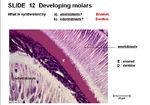Difference between revisions of "Ameloblasts"
Jump to navigation
Jump to search
(New page: {{toplink |backcolour =BCED91 |linkpage =Alimentary - Anatomy & Physiology |linktext =Alimentary System |maplink = Alimentary (Concept Map)- Anatomy & Physiology |pagetype =Anatomy |sublin...) |
m (Text replace - '|maplink = Alimentary (Concept Map)- Anatomy & Physiology' to '|maplink = ') |
||
| Line 3: | Line 3: | ||
|linkpage =Alimentary - Anatomy & Physiology | |linkpage =Alimentary - Anatomy & Physiology | ||
|linktext =Alimentary System | |linktext =Alimentary System | ||
| − | |maplink = | + | |maplink = |
|pagetype =Anatomy | |pagetype =Anatomy | ||
|sublink1=Oral Cavity - Teeth & Gingiva - Anatomy & Physiology#Anatomy of the Enamel Organ | |sublink1=Oral Cavity - Teeth & Gingiva - Anatomy & Physiology#Anatomy of the Enamel Organ | ||
Revision as of 22:52, 2 July 2010
|
|
Introduction
Ameloblasts are cells in the enamel organ which forms the tooth. They secrete enamel.
Properties
- Epithelial cells
- Lines the inner surface of the enamel organ
- Derived from epithelium
- Maintains connections with the newly synthesised enamel through cellular projections called Thomes' fibres
- Enamel is acellular so once the connection with the ameloblasts via the Thomes' fibres is lost (upon eruption), enamel matrix cannot be remodelled
- A single layer of very long columnar cells
- Hexagonal in cross section
- Elongated basally sited nuclei
